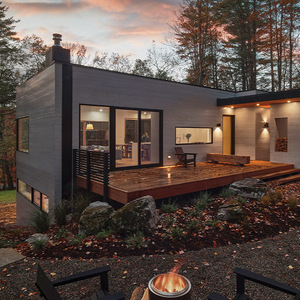I have a 50’s house that I am remodeling and have a situation with the kitchen lights. Right now there are two lights in the kitchen, one is controled by one switch and the other is controlled by two other switches.
I want to replace the two lights with 4 recessed cans and have them all on the two switches.
I have attached an as-is wiring diagram. Can someone help me diagram how I need to proceed?
Thanks
Mike



















Replies
Are all the lights presently on one breaker or fuse?
Is there access to spaces above the lights? Attic?
Is the wiring romex, conduit or some other system?
Is this wiring in good shape?
Will you be insulating around the new cans?
Lots of questions but knowing these will help greatly in suggesting solutions.
Yes, all lights are supplied by one breaker.
I have access in the attic. It is very hot up there.
The existing wiring looks like 14 ga. 2 wire, and is in pretty good shape undisturbed for 50 years until recently.
Attic has blown in insulation that is 3 in above ceiling joists. I bought Insulation Contact rated cans.
You say that the cables are all two wire. (Discounting the ground of course.) And there are no red wires. Hmm. If all this is true it could be easy.
I would use IC rated old work cans from a major manufacturer. Avoid the Emerald and Diamond brands that are IMHO a covert Chinese waste disposal plot. Old work cans can be cut in and mounted from the cool side of the ceiling. Locating the joists is the hardest part in cutting them in but a gander at the attic area can save you having to repair plumbing and flex ducts.
Locate the joists and taking into account locations without sufficient height, plumbing, etc. locate the cans. I sometimes past up pieces of tape up at proposed locations and consider the situation from floor level. You may have to modify your original plan to compesate for things in the way and symetry. Make sure you give some clearance to the joists and watch for strapping.
Most manufacturers include a cut template. Try this out on a piece of cardboard and check the fit. Sometimes these templates are oversized or are for a differant can. You can widen a small hole. Cut too big you have a problem. Not the end of the world but something to be avoided. The hole should be just large enough to get the can in.
Cut the holes in. You could use a sawzall or a large hole saw but for just a few cans I use a hand held drywall, or keyhole saw, because it gives me a feel for any hidden wires or pipes. Wear a bandanna around your neck and draped a bit to keep the dross from going down your collar. Wear safety glasses.
OK. Check the breaker size and turn off the breaker. Double check to see that the circuit is in deed dead. Look carefully at the wires to determine if it is #12 or 14. The new wire should match the original in guage.
Look at the two boxes controled by the 3 way switches. One will have one cables and the other two. I'm not psychic because if neither have any 3 wire cables this is how they are wired. Go to the one with two and figure out which cable goes to the other light. You can track the wire up in the attic or short wires and ring them with a meter.
The cable that does not go to the second light will be your switched leg that is controled by the switches. This is the one you will be hooking up to. Abandon the other. Complete removal is good but isolating and wire nutting alll three conductors together on both ends is almost as good.
String out your new romex. Unrolling it will prevent sloppy loops and make handling it easier. Stuff the cable through an access hole in the exsisting box. Given some manipulation and luck, assuming the distance isn't too far, you might be able to get the new cable from the box to the first hole. With your arm up the hole cut for the can and someone working the cable you might avoid some attic work. Repeat 3 times leaving about 3 feet of slack hanging in each hole. I would run it as a daisy chain. Old box to can 1 to can 2 to can 3 to can 4. This limits the number of wires in each box.
OK. Wiring. One of the can locations should have only one cable hanging down. Grab the cable and starting about 8" from the end slit the jacket with a sharp knife point. Jab and run it down the center. Don't damage the insulation. Take it slow. Remove the KO on the integral connector.Most include a spring connector. If the can doesn't have a connector install one. Shove the cable into the box on the first can. Get the jacket into the box so the connector is not bearing on the insulation.Repeat with the other three cans with each getting two cables.
Wire the cans by striping the wires and using wire nuts. White to white. Black to black or other color. Bare to bare or green. Make sure you ground the boxes. Install the junction box covers on the cans and hang the cans. I like to shoot a bit of silicon sealant around the cans to make a seal with the ceiling. Better to keep the AC inside. While your there install lamps, bulbs, and the trims.
Go to the box with the switched leg. You remember the switched leg. Recheck to make sure it is still dead. Better it than you. Wire W-W, B-B, Ground- Ground making sure the box is grounded if it is metal. You are essentially done. I would staple the cables in the attic if possible. maintain enough slack at each can to be able to drop the can. The other box controled by the third switch can be maintained, blank plated or shoved into the attic after being plated. Much the same with the other old boxes. If any have wire you just can't just fill them with plaster. If not used I would remove the switch, cap the wires and blank the witch box.
If the boxes have more than the expected one and two cables post back. The variation is not difficult to deal with. If you find any 3 wire cables a different configuration will need to be used. Nothing too complicated.
Sorry guys it seems that my attachment didn't make it. I'll try it again.
One other note. The existing wires are TWO wire no ground only B and W. This being the case how should I ground the new cans. I would like to use the old wire as it is already in place. Pulling new wire would be a major headache but i will if I have to. Though I'm not sure I could pull a new wire from the panel in the basement to the attic. Any tips on pulling wires.
Thanks
Mike
If a ground is not available, not unusual in a house this age, you will probably be better not using one. That said be sure you really don't have one. Some early grounds were a small 16 gauge wire that is sometimes run very close to the box and frequently attached with a small clip. Both the wire and clip can be difficult to see if some dirt or corrosion is present. A strong flashlight helps.
While I prefer a grounded circuit I wouldn't be overly concerned if you don't have one. If the panel was close and it had a space available I would probably push gently for running a new circuit with new cables.
I'm not sure what the jpg. is depicting. It looks tangled to me. The kitchen light as depicted in the diagram could not be run in only two conductor cables as shown. I suspect that there is a 3 wire cable run between the switch boxes and that only one of the switch boxes has a cable run to the light box.
To clarify you might report how many cables each box has entering into it and how many wires each cable has. No need to track the cables as these number say quite a bit. Three-way switches need 3 wires to work safely and correctly. There is a way to run it with two wire cables independent of misusing a ground but this is neither safe nor accepted practice.
When you say "...and have them all on the two switches" which two switches do you mean? The two that control the one light, or one of those and the one that controls the other light? Hope that makes sense.
Rich Beckman